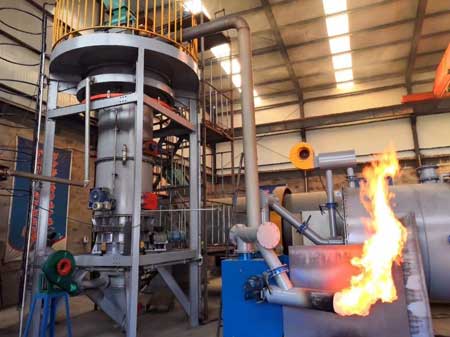Pyrolysis Plant
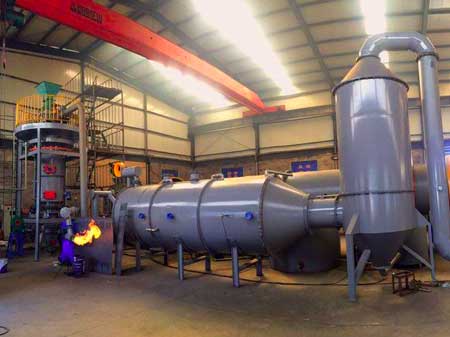
What is Pyrolysis Plant
Pyrolysis technology is developed for processing biomass and other organic wastes by thermochemical processing, except for heat energy, the by products include liquid and organic materials and fine charcoal. AGICO manufacture pyrolysis plant equipment used to turn various types of waste into organic gases, charcoal, and biomass liquids, it is a sustainable energy technology which realize the purpose of energy recycling and waste processing of agriculture and forest, industrial waste, plastic and coal.
What we supply: AGICO specializes in alternative energy services, providing Customized Pyrolysis Plant Solutions for projects of various scales with long-term operation and maintenance.

Grate Furnace and Pyrolysis Furnace Compare
When it comes to processing biomass waste and industrial waste, pyrolysis and gasification furnace have many advantages compared with traditional grate furnace, here are the details:
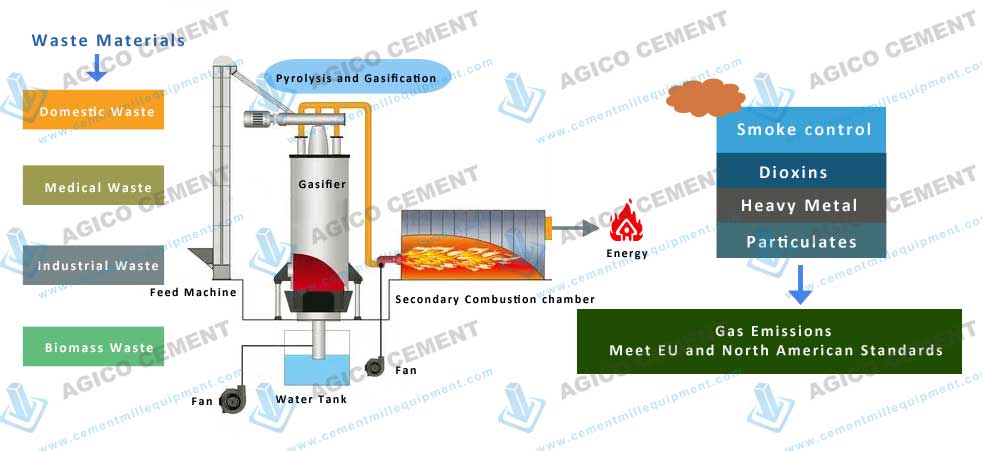
| Waste Processing - Grate Furnace and Pyrolysis Furnace Compare | ||
|---|---|---|
| Comparison Criteria | Grate Furnace | Pyrolysis/Gasification Furnace |
| Combustion Mechanism | Directly burns waste at temperatures of 800-1000°C; conventional combustion mechanism. | Utilizes a 2-stage process involving thermal decomposition and gasification of waste, followed by the combustion of small combustible gases at temperatures of 850-1100°C; advanced combustion mechanism. |
| Furnace Structure and Grate Material | Complex structure with a larger footprint; the grate operates at high temperatures, requiring high-quality materials. | Relatively simple and compact structure; the grate operates at lower temperatures, allowing for the use of lower-grade materials. |
| Types of Waste Processed | Primarily designed for municipal solid waste but can handle industrial waste. Limited capacity for hazardous waste. | Can process municipal solid waste, industrial waste, and high-calorific hazardous waste, including medical waste. |
| Land Area (for 300 t/d) | Requires 40-50 acres of land. | Requires 30-40 acres of land. |
| Operating Costs | Higher operating costs. | Lower operating costs. |
| Fly Ash Emissions | Higher fly ash emissions, approximately 5% of total waste. | Lower fly ash emissions, approximately 1% of total waste; environmentally friendly. |
| Acidic Substances and Dust Emissions | Higher original values of acidic substances such as SO2 and NOx; dust emission concentration of 6000-8000 mg/Nm3. | Lower original values of acidic substances such as SO2 and NOx; dust emission concentration ≤3000 mg/Nm3. |
| Factory Environment | Challenging environmental control in the factory area; emits some bottom ash, leachate, noise, and odor. | Good environmental control in the factory area; minimal emissions of bottom ash, noise, and odor. |
Pyrolysis Furnace - Main Equipment of Pyrolysis Plant
The main pyrolysis plant equipment is pyrolysis furnace, or pyrolysis kiln, which is called pyrolysis reactor, it is the temperature control machine of pyrolysis plant, combustion chamber temperature ranges from 950°C~1050 °C, secondary combustion chamber ( 950°C~1100°C). Heat created by pyrolysis reactor is aimed to complete pyrolysis and gasification process.
The cost of pyrolysis furnace differs according to the raw material types and capacity, if you need expert help on choosing the most fitable furnace model, simply contact us now by email or call.
Pyrolysis and Gasification Process Introduction
Pyrolysis is the process of heating organic substances in the absence or limited presence of oxygen. This process involves complex chemical reactions, including the breaking of large molecular bonds, isomerization, polymerization of small molecules, ultimately leading to the formation of various smaller molecules. Under the same pyrolysis environmental temperature, different substances exhibit distinct thermal gravimetric analysis (TG) and derivative thermal gravimetry (DTG).
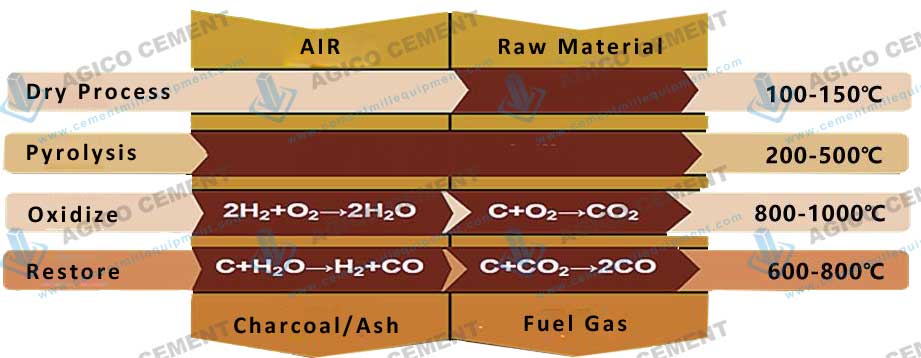
During pyrolysis, water vapor, free oxygen, or bound oxygen undergo thermal chemical reactions with the carbon in the fuel, resulting in the production of combustible gases. The pyrolysis and gasification of waste are intricate processes, and the conditions for these reactions can vary significantly. Although pyrolysis plant can be customized for different wastes, the main process of pyrolysis and gasification is the mostly the same, which include raw material drying, pyrolysis, gasification(oxidize and restore).
Pyrolysis and Gasification Plant Temperature Control
| Pyrolysis and Gasification Project | Unit | Rated Value |
|---|---|---|
| Combustion Chamber Combustion Layer Temperature | °C | 950~1050 |
| Combustion Chamber Outlet Flue Gas Temperature | °C | 600~950 |
| Secondary Combustion Chamber Temperature | °C | 950~1100 |
| Residence Time of Flue Gas in the Secondary Combustion Chamber | s | ≥2 |
| Secondary Combustion Chamber Flue Gas Outlet Temperature | °C | ≥850 |
| Outer Wall Temperature | °C | ≦50 |
| Noise | d B(A) | ≦85 |
| Reduction Ratio | % | ≥86 |
| Ash Content Reduction Rate | % | ≦3 |
Waste Gas Control - Pyrolysis Plant
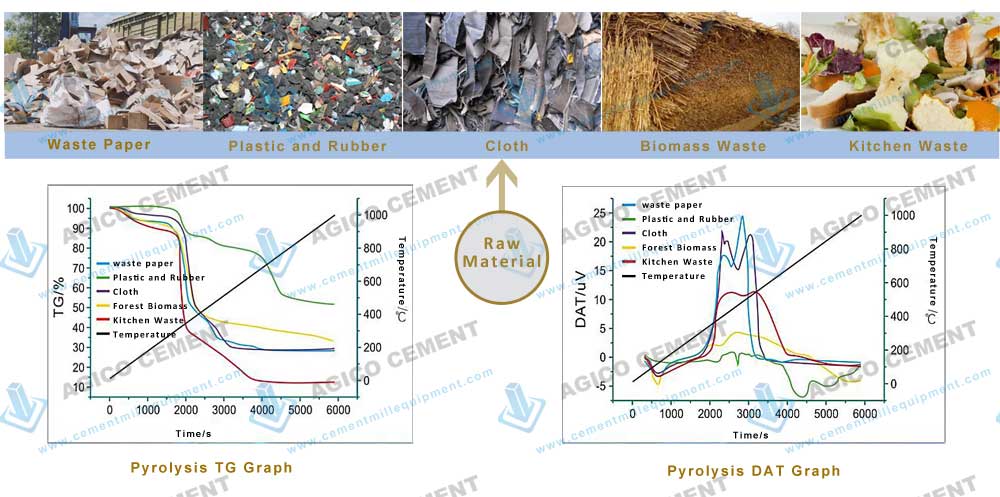
Sampling Data for Combustion Chamber Outlet
| Sampling Data for Combustion Chamber Outlet | ||||||
|---|---|---|---|---|---|---|
| Sample | Combustion Chamber Outlet Temperature | CO Concentration | Nox Concentration | SO2 Concentration | HCL Concentration | O2 Concentration |
| 1 | 624°C | 48810 ppm | 9.25 mg/m³ | 6.86 mg/m³ | 118.76 mg/m³ | 2.6% |
| 2 | 595°C | 51900 ppm | 0.21 mg/m³ | 3.05 mg/m³ | 131 mg/m³ | 3.1% |
| 3 | 787°C | 39860 ppm | 17.53 mg/m³ | 2.59 mg/m³ | 65.63 mg/m³ | 0.9% |
| 4 | 464°C | 62790 ppm | 19.01 mg/m³ | 4.79 mg/m³ | 55.11 mg/m³ | 2.3% |
| 5 | 842°C | 44900 ppm | 6.97 mg/m³ | 2.52 mg/m³ | 98 mg/m³ | Not Detected |
| 6 | 855°C | 57900 ppm | 9.86 mg/m³ | 27.35 mg/m³ | 101.91 mg/m³ | 1.8% |
| Average | 694.5°C | 51027 ppm | 10.47 mg/m³ | 7.86 mg/m³ | 95.07 mg/m³ | 1.78% |
Leachate Toxicity for Various Substances
| Leachate Toxicity for Various Substances | |||
|---|---|---|---|
| Substance | Leachate Toxicity (mg/l) | Detection Limit (mg/l) | Maximum Leachate Toxicity (mg/l) |
| As (Arsenic) | Not Detected (N.D) | 0.001 | 1.5 |
| Cd (Cadmium) | Not Detected (N.D) | 0.0005 | 0.3 |
| Cu (Copper) | 0.29 | 0.04 | 50 |
| Zn (Zinc) | 0.53 | 0.03 | 50 |
| Be (Beryllium) | Not Detected (N.D) | 0.002 | 0.1 |
| Ba (Barium) | 1.05 | 0.02 | 100 |
| Ni (Nickel) | Not Detected (N.D) | 0.1 | 10 |
| Hexavalent Cr (Chromium) | 0.02 | 0.004 | 1.5 |
| Cr (Chromium) | 0.47 | 0.005 | 10 |
Incineration Slag Leachate Toxicity Test Data
| Incineration Slag Leachate Toxicity Test Data | |||
|---|---|---|---|
| Substance | Leachate Toxicity (mg/l) | Detection Limit (mg/l) | Maximum Leachate Toxicity (mg/l) |
| Cyanide | 0.18 | 0.004 | 1.0 |
| Fluoride | 0.28 | 0.05 | 50 |
| Mercury (Hg) | 0.003 | 0.0005 | 0.05 |
| Lead (Pb) | Not Detected (N.D) | 0.001 | 3 |
Is Pyrolysis Plant Profitable
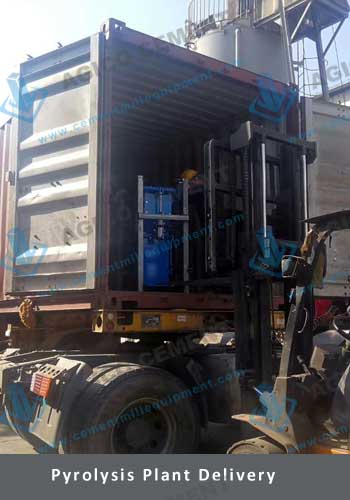
Here are the 7 most important factors affecting the profitability of waste pyrolysis plants:
- Feedstock Selection and Availability: Different feedstock materials have varying energy content and processing requirements, directly affecting costs and product yields.
- Technology and Equipment Efficiency: Modern and efficient pyrolysis equipment can improve conversion rates and minimize energy losses.
- Product Quality and Market Demand: Meeting product specifications and identifying lucrative markets is essential for revenue generation.
- Regulatory Compliance: Failure to adhere to environmental regulations and emissions standards standards can result in fines and increased operating costs.
- Energy Consumption and Efficiency: Managing energy consumption and implementing energy-efficient processes can help reduce operational expenses.
- Scale of Operations and Economies of Scale: Larger plants may have lower production costs per unit of output, but they require substantial initial investments.
- Pyrolysis plant cost: pyrolysis project investment can be affected by the equipment cost and maintanence cost.
Pyrolysis Plant Solution from AGICO:
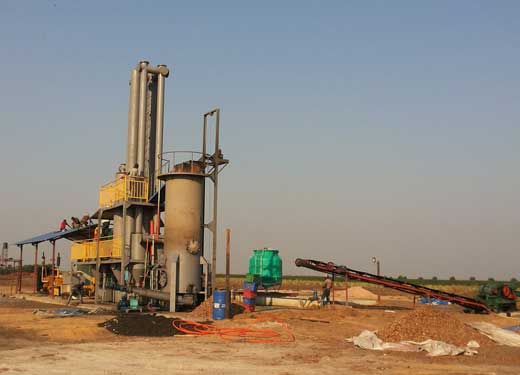 Biomass Pyrolysis Power Generation Plant
Biomass Pyrolysis Power Generation Plant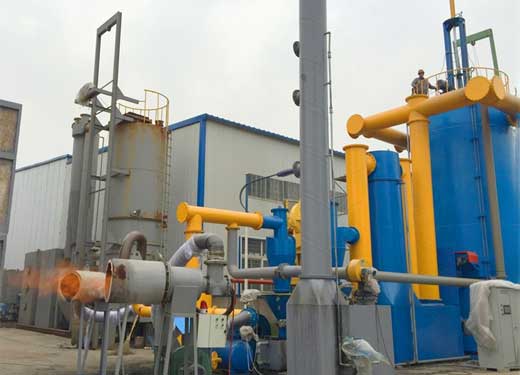 Waste Pyrolysis Power Generation Plant
Waste Pyrolysis Power Generation PlantCommon Pyrolysis Plant Types by Material
| Pyrolysis Plant Type | Processed Material |
|---|---|
| Tire Pyrolysis Plant | Waste Tires |
| Plastic Pyrolysis Plant | Plastic Waste |
| Biomass Pyrolysis Plant | Wood, Agricultural Residues |
| Waste Rubber Pyrolysis Plant | Rubber Materials |
| Waste Oil Sludge Pyrolysis Plant | Oil Sludge |
| Medical Waste Pyrolysis Plant | Medical Waste |
| Mixed Waste Pyrolysis Plant | Municipal Solid Waste (MSW) |
| Tire to Oil Plant | Waste Tires |
| Continuous Pyrolysis Plant | Various Materials (Continuous Process) |
| Batch Pyrolysis Plant | Various Materials (Batch Process) |
| Scrap Tyre Pyrolysis Plant | Scrap Tires |
| Waste Plastic to Oil Plant | Waste Plastic |


